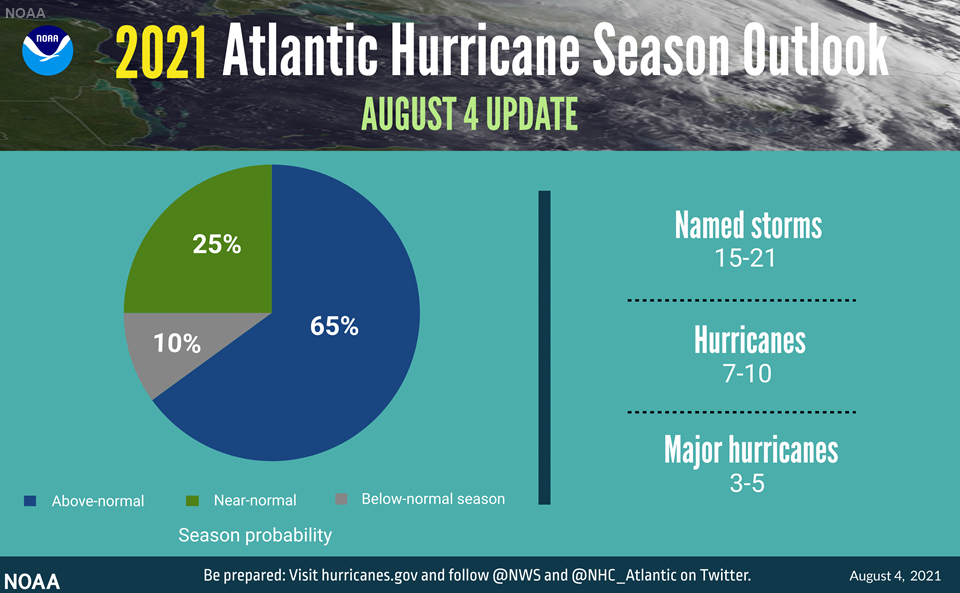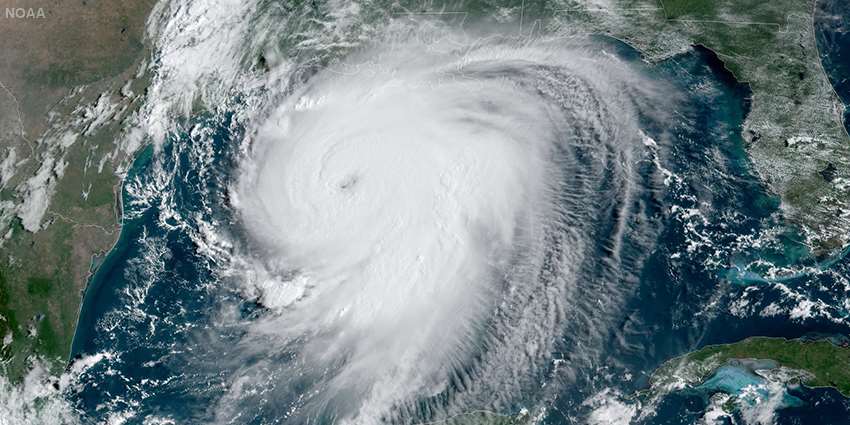Editor's Note: This article was updated on May 26, 2021 to include the official 2021 Atlantic hurricane season outlook from the National Oceanic and Atmospheric Administration's Climate Prediction Center. On August 9, 2021, this article was updated again to reflect the National Oceanic and Atmospheric Administration's mid-season update.
The 2021 Atlantic hurricane season is swiftly approaching. With the potential for a busy season ahead, now is the time to prepare.
Looking back, looking ahead
The 2020 Atlantic hurricane season was a historic one, with the highest number of storms on record and the second highest number of hurricanes. There were 30 named storms, including 13 hurricanes and six major hurricanes.
On June 1, the 2021 Atlantic hurricane season officially started, and it will end on November 30. Storms have formed before the official season start date for the past six years.
This year, the 30-year averages used for the Atlantic hurricane season will be different. The National Oceanic and Atmospheric Administration’s (NOAA) Climate Prediction Center will begin using the 1991–2020 period for hurricane season averages, instead of 1981–2010. Previously, the averages were 12 named storms, seven hurricanes and three major hurricanes. The updated averages will be 14 named storms, seven hurricanes and three major hurricanes.
The Tropical Weather & Climate Research team at Colorado State University (CSU) is predicting that the 2021 Atlantic hurricane season will be above the new averages. The CSU research team predicts there will be 17 named storms, with eight hurricanes and four major hurricanes.
El Niño, a cyclical weather pattern, isn’t currently expected during peak Atlantic hurricane season. That’s part of why the CSU team is predicting the above-average season: El Niño tends to suppress Atlantic hurricane activity by increasing certain winds, which tear hurricanes apart as they’re forming.
On May 20, NOAA's Climate Prediction Center released its official 2021 Atlantic hurricane season outlook. NOAA is also predicting an above-normal hurricane season, with 13 to 20 named storms. Of those storms, NOAA expects that six to 10 could become hurricanes, and three to five of those could be major hurricanes. On August 4, NOAA released a slightly increased mid-season update, predicting 15 to 21 named storms, of which seven to 10 could become hurricanes and three to five could become major hurricanes.

Preparing for hurricane season
The best time to prepare for hurricanes and learn about your risk factors is “before there’s ever a cloud in the sky,” said Bill Read, former director of the National Hurricane Center, in 2020.
Preparation starts with learning how to understand a hurricane forecast, so you know what might be heading your way. Read also recommends building a habit of checking the weather forecast daily, because cultivating weather awareness will help you stay in the know going forward.
It’s also important to understand your personal risk factors. Tools like Buyers Be-where, from the Center for Texas Beaches and Shores, help people understand their property’s risk from hurricanes, flooding and more.
For those who want to dig deeper, mapping tools like the Texas A&M Hazard Reduction and Recovery Center’s Coastal Bend Hurricane Evacuation Study Planning Atlas and the Institute for a Disaster Resilient Texas’ Flood Risk in Texas interactive map catalog can give added layers of context for hurricane season.
Once you’re armed with the necessary information, make an emergency plan with your family. Know how you will stay informed, what your evacuation routes and zones are and where you would meet if you were separated.
Then, create a disaster supplies kit, which should include a first aid kit, food and water and important documents, among other things. Given the continuing COVID-19 pandemic, disaster kits should also include face masks, gloves and hand sanitizer.
The COVID-19 pandemic is likely to continue complicating hurricane response this year, though vaccinations are on the rise across Texas. You can help your community be more resilient by talking with your local fire department, nonprofits or house of worship about preparing for hurricane season, said Michelle Meyer, Ph.D., director of the Texas A&M University Hazard Reduction & Recovery Center, in 2020.
The bigger picture
Once hurricane season preparations are done, it’s worth looking at the bigger picture of hurricanes. Texas cities are growing, and with them, more concrete and other impervious surfaces. That makes soaking up floodwaters harder, so researchers are working on solutions with green infrastructure and flood education.
Hurricanes can affect whole ecosystems as well. Large influxes of rain can change salty coastal wetlands, and polluted floodwaters can travel a hundred miles to delicate ecosystems like coral reefs.
Hurricanes aren’t likely to stop their broad impacts any time soon: storms are getting wetter and intensifying faster, and strong storms are getting stronger. So whether you’re learning about hurricanes for the first time or just preparing for another season, now is a good time to get ready.
Resources
Understanding your hurricane risk:
Staying informed:
- Texas Ready: Be Informed
- Watches, warnings and advisories for Texas
- National Hurricane Center
- Coastal Bend Hurricane Evacuation Study Planning Atlas
- Flood Risk in Texas interactive map catalog
Preparing for hurricane season:
- Texas A&M AgriLife Extension Disaster Education Network Hurricane Resources
- Texas hurricane evacuation routes
- Harris County evacuation map
- Disaster supply checklist
- Emergency food and water supplies
- After a disaster
Digging deeper:


